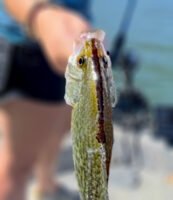Lindsey Lucas shows off a respectable white crappie. While not extremely distinct, one way to
distinguish white crappie from black crappie is the pattern of vertical bars or stripes on the side.
The Reel Deal: Different Kinds of Crappie
by Lindsey Lucas
“Set the hook,” shouted Jordan Isaacs with Freedom Guide Service.
My hookset was already in motion and I immediately felt the satisfying weight of a well-hooked crappie and swiftly reeled in the 13-incher.
This fish, however, had a unique dark black stripe extending from its dorsal fin down to its nose.
“You’ve officially caught three types of crappie this trip,” Isaacs said. “You’ve caught black crappie, white crappie, and now a magnolia crappie.”
According to biologists, the Magnolia crappie is a hybrid cross between black-striped black crappie and white crappie. This fish has a black stripe running from the front of the dorsal fin along the top of the body, normally extending through to the upper jaw. Magnolia crappie can also be known as blacknosed crappie.

White crappie and black crappie can be easily confused if you do not fully understand what to look for. White crappie are usually (but not always) a lighter color. They do usually have markings that seem to form vertical lines running up and down the sides. White crappie usually have 5-6 dorsal spines – the first “spikes” in the fin on the fish’s back. Another cool fact about white crappie is they tend to not dig into the mud at the bottom of the lakes and rivers and prefer to stay closer to brush piles.
Black crappie are usually (but not always) a darker color. The patterns and spots on their sides are random and do not form vertical lines. Black crappie usually have 7-8 spines on their dorsal fin.
Black crappie are often more oblong or football-shaped whereas white crappie are somewhat more elongated.
Magnolia crappie, again, are a hybrid species and might have characteristics of each, except they will always have the distinct black stripe from their nose lip to their first dorsal spine. They sometimes occur naturally. According to Panfish Nation, magnolia crappie tend to be a rare species but are found in 14 different states.
However, in many cases fisheries biologists create sterile blacknose (magnolia) crappie hybrids in a hatchery. The distinct black nose helps biologists and creel clerks determine recapture rates whenever they stock crappie in a body of water.
With a little practice anyone can learn to recognize the three different types of crappies. In my opinion, however, they all look the same in the grease!
(Lindsey Lucas, 15, is obsessed with all things outdoors with dreams of becoming an accomplished outdoor media provider and influencer. She hopes the tips and experiences she shares will prove inspirational for other young men and women in her Gen Z age group.)



